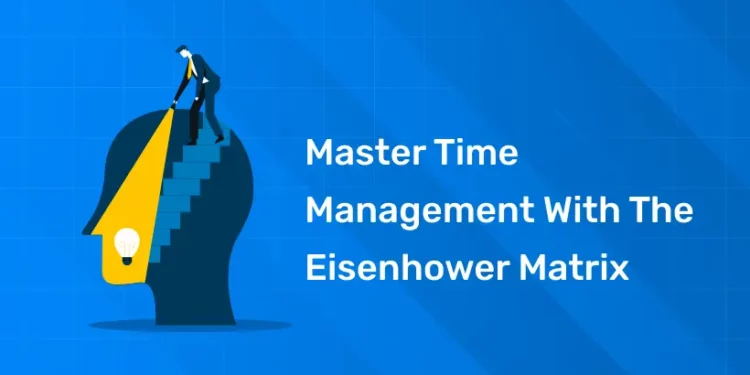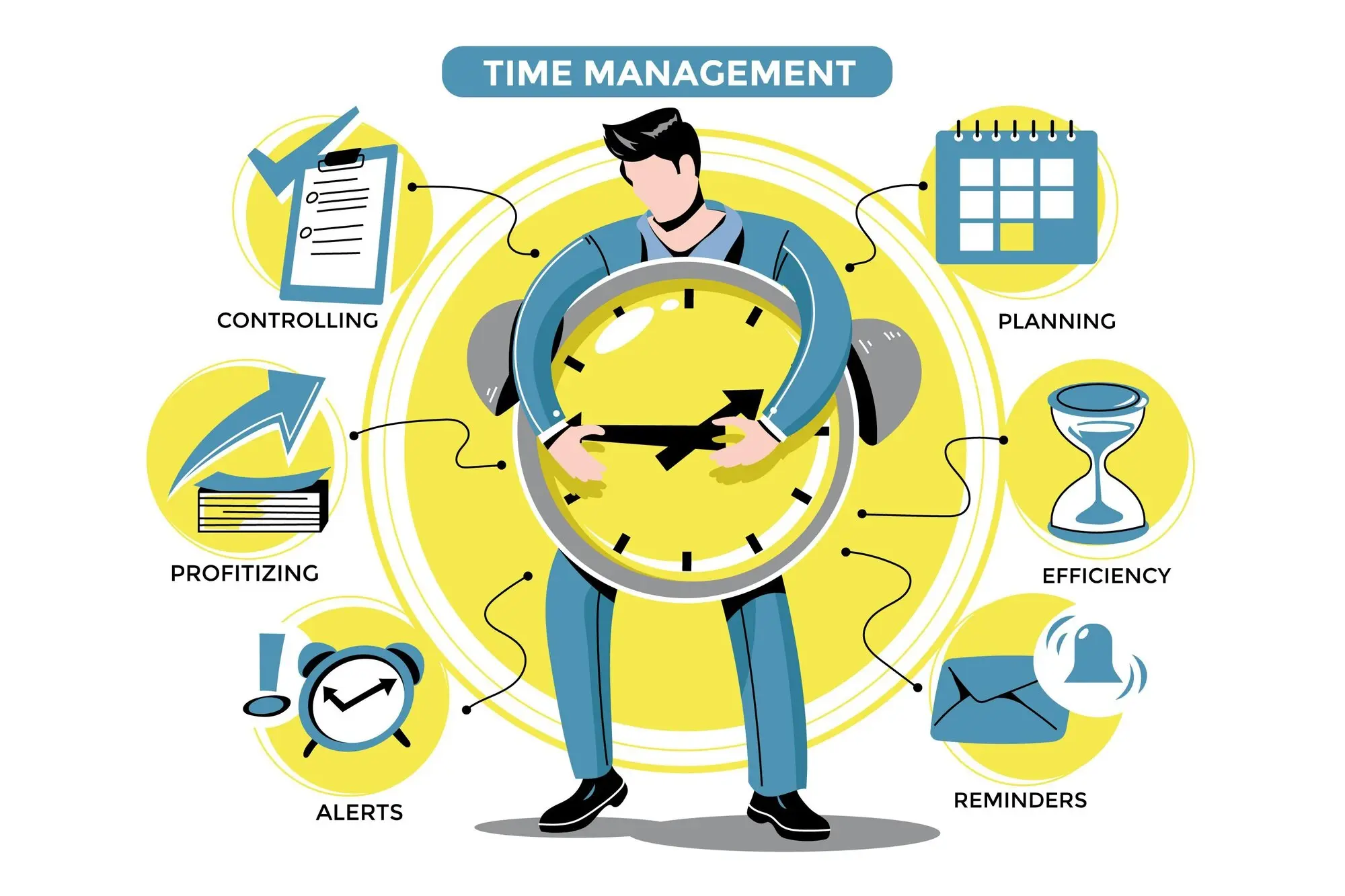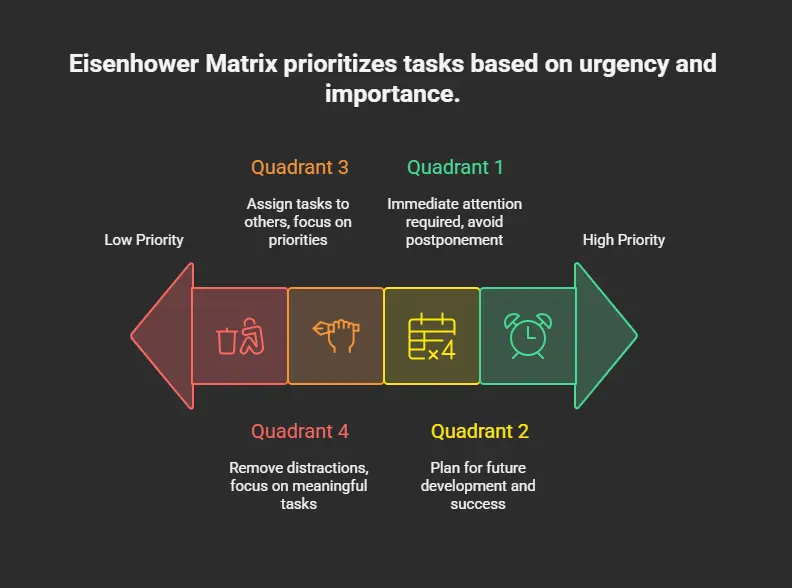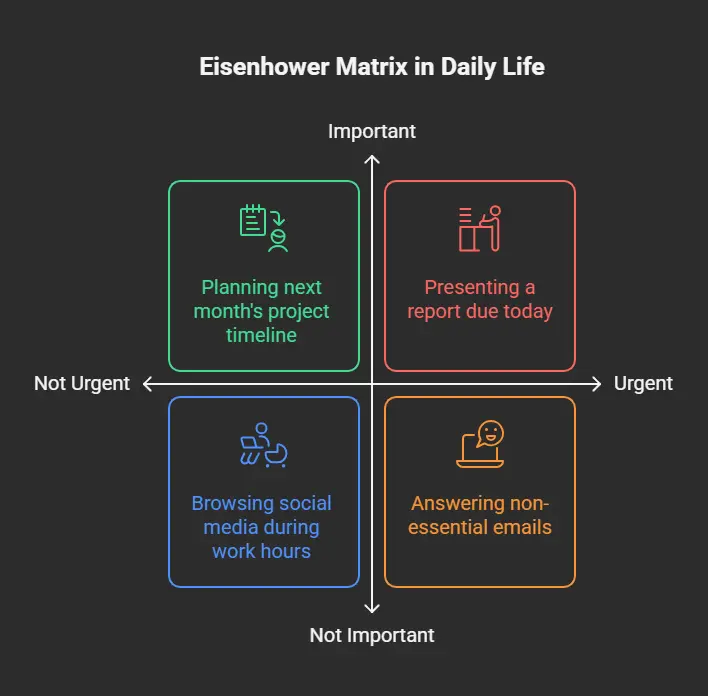Table of Contents
Do you feel overwhelmed by your to-do list? You are not alone. With so many tasks pull us in different directions, it can be difficult to know what to focus before. This is the place where the Eisenhower Matrix comes in – a simple tool that helps you manage your time by organizing tasks on the basis of high-priority and important. In this blog you will learn how to use matrix to focus, reduce stress and more every day.
Begin Your Personality Transformation- Enroll Today!
Introduction
Time management is without taking the maximum benefit from the day or feeling overwhelmed. When you manipulate a while properly, you can make attention on what matters, reduces stress and can have a higher stability among work and private lifestyles. But with many duties competing in your attention, it is easy to get caught in a cycle of response rather than plan.
This is the place where the Eisenhower Matrix comes. It is a practical tool that helps you organize your features after any urgency and significance. President named after Dwight D. Eisenhower, this method breaks your to-do-list in four simple categories. So you always know what to do now, what is your plan, what to do after week, what to let go, and what to go. Using this approach can help you be clear, focused and stay under your time control every day.
Why Time Management Matters
1. Helps You Focus on What Matters
Time management enables you to pick out the obligations that genuinely count and stop wasting energy on things that don’t. When you know your priorities, you can spend time doing work that moves you forward, instead of just staying “busy.” This allows you to say “no” more confidently to distractions. It also helps you recognize when you’re investing your time in things that don’t align with your goals. Over time, this clarity leads to more meaningful progress. You’ll find it easier to focus on results instead of just tasks.
2. Reduces Stress and Overwhelm
A packed schedule can feel overwhelming, but good time management helps break tasks into smaller steps. This makes your day easier to handle and gives you greater peace of mind. You’ll feel more in control rather than rushing from one thing to the next. Small wins throughout the day can reduce anxiety and build momentum. Planning ahead also prevents the panic of last-minute surprises. With a calm and focused mind, you’re better equipped to handle challenges when they arise.
3. Boosts Productivity
Being productive does not mean nonstop work – it means working smart. With a plan for better time, you’ll complete tasks faster and avoid last-minute pressure. You have more energy to focus and become less distracted. Structured time reduces wasted hours and increases efficiency. You can track your progress and adjust your approach as needed. As your productivity improves, so does your confidence in your ability to manage your workload.
4. Improves Decision-Making
When your time is managed well, you can make better decisions. You know what tasks deserve a “yes” and which can wait or be dropped. It creates more confidence in your daily choices and helps reduce small mistakes. Time to think means time to evaluate options clearly. Rushed decisions often lead to poor outcomes, but time management gives you space to assess. Better decisions lead to better results and fewer regrets.
5. Creates Time for Balance
Good time management helps make room for things outside of work – like rest, family, hobbies, or fitness. This allows you to enjoy life without guilt or burnout. Balance leads to better mental and emotional health. When you plan your time, you protect your personal life from being overrun by responsibilities. You’re more likely to show up present and energized in every area of life. Balance doesn’t just happen – it’s created through mindful time choices.
6. Builds Confidence and Motivation
It feels great to complete tasks and achieve your goals. It gives you a sense of progress and boosts your confidence. This positive feeling motivates you to keep going and aim higher. Time management helps you prove to yourself that you can stay disciplined. Every small success adds up to bigger wins. The more you stay on track, the more your belief in yourself grows.
Boost Your Skills & Kickstart Your Career!
Employability and Personality Development Course by Entri App: Enhance your communication, confidence, and job-ready skills to excel in your career.
Join Now!The Four Quadrants of the Eisenhower Matrix
Eisenhower Matrix is an important tool to manage your time by sorting tasks into four simple boxes, or “quadrants”. Each quadrant tells you what to do with some task – whether it is to do it now, plan it later, give it to someone else, or let it go. It helps you to be focused and avoid wasting time on things that mean nothing.
Quadrant 1: Urgent and Important (Do It Now)
The features of this quadrant require your immediate attention, and if you ignore them, there are real consequences. These are things that keep the day moving and often come with pressure, such as completing a deadline, handling an emergency, or finishing last-minute work. If something is both urgent and important, you cannot postpone it. The best way is to take immediate action, so that you do not fall behind or create more stress for yourself. These tasks are usually unavoidable, so tackling them promptly builds trust in yourself and helps prevent crises from escalating.
This quadrant can be intense, so it’s important to manage it carefully. Spending too much time here can lead to constant stress and burnout. Ideally, you want to reduce how often you’re in this space by handling tasks earlier, before they become urgent. Developing good habits, like planning ahead or setting reminders, can keep your time in this quadrant under control. Remember: urgent should not always mean unplanned.
Quadrant 2: Not Urgent but Important (Schedule It)
This is the place where your most meaningful work lives. These tasks are not required to be handled this second, but they are vital for your future development and success. Examples include long-term planning, learning new skills, exercising, or spending time with loved ones. Since they’re easy to delay, it’s essential to block time on your calendar for them. By doing this, you ensure you build a better future without unnecessary pressure.
Investing in Quadrant 2 is how you prevent future emergencies. It’s where strategy, health, relationships, and personal growth all reside. The more time you spend here, the more proactive and balanced your life becomes. Over time, this quadrant helps you minimize urgent tasks because you’re taking care of things before they escalate. This is the zone of leadership, intention, and long-term achievement.
Quadrant 3: Urgent but Not Important (Delegate It)
These tasks feel urgent, but they don’t need to be done by you. They may suddenly appear, such as responding to routine emails, attending unnecessary meetings, or helping others with non-essential tasks. Although they may look important at the moment, they often take time away from what truly matters. If possible, delegate them to someone else so you can focus on your top priorities. Delegating wisely ensures that your energy goes to tasks that align with your goals.
This quadrant can be a big source of distraction if not handled properly. Many people get stuck here, reacting to other people’s requests instead of their own agenda. It’s essential to evaluate whether each “urgent” task really requires your involvement. Learning to say no or set boundaries is key to managing this space. Freeing yourself from unnecessary involvement will make a noticeable difference in your productivity.
Quadrant 4: Not Urgent and Not Important (Eliminate It)
This quadrant is the place where time does not take anyone into account. This includes distractions and activities that provide very little or no value, such as excessive social media, watching too much TV, or just doing things to “stay busy.” These tasks do not help you get ahead or support your goals. It is best to reduce or remove them from your routine so you can use your time and energy for more meaningful things. Eliminating these habits creates space for growth, focus, and real fulfillment.
While these activities may feel relaxing or harmless, too much time here can lead to regret and lost opportunities. Being aware of how often you slip into this quadrant is the first step toward change. Try replacing low-value activities with something intentional—even rest can be more rewarding when done with purpose. Creating boundaries around your time, such as setting screen limits or using time-tracking apps, can help reduce unconscious habits. The goal is not perfection, but more intentional use of your most valuable resource: time.
How to Use the Eisenhower Matrix Effectively
The Eisenhower Matrix is a simple but powerful tool that helps you organize your actions in urgency and significance. When used properly, it can help you feel overwhelmed and start working smartly. Here are described how to use matrix effectively in your daily life.
1. List All Your Tasks
Start by writing what you need to do. Don’t worry about the order – just get everything from your head and on paper or a digital patch. This will give you a clear view of what is on your plate. Once you have your list, you can start sorting the tasks in the correct categories.
2. Sort Your Tasks into the Four Quadrants
Now take each task and place it in one of the four boxes of the matrix:
-
Quadrant 1 (Urgent and Important): Do these tasks right away.
-
Quadrant 2 (Not Urgent but Important): Schedule time for these tasks soon.
-
Quadrant 3 (Urgent but Not Important): Try to delegate these to someone else.
-
Quadrant 4 (Not Urgent and Not Important): Limit or remove these from your day.
This step helps you decide what really needs your attention and what doesn’t.
3. Focus on One Quadrant at a Time
Start by handling Quadrant 1 tasks – they are your top priority. When they are done, you change your attention to the Quadrant 2 tasks. These are equally important, but further plans can be laid down. Do not steal your time immediately, but less important tasks (Quadrant 3). And try to eliminate the time-wasting from Quadrant 4.
4. Review and Adjust Regularly
Your tasks and priorities can be changed, so it is a good idea to do daily or weekly review of your matrix. It keeps you on track and helps you make better decisions over time. The more you use matrix, the more natural you will feel.
Real-Life Examples of Eisenhower Matrix in Action
Eisenhower Matrix is not just a theory – it works in everyday life. Whether you are a student, a working professional or administration of a house, this tool can help you solve your tasks and focus on what matters most. Let’s look at some real examples of how it works in action.
1. Example for a Busy Office Worker:
Quadrant 1 (Urgent & Important): Present a report due to today, join the client call, suddenly fix the system error.
Quadrant 2 (Not Urgent but Important): Planning next month’s project timeline, participate in a skills building workshop, updates the CV.
Quadrant 3 (Urgent but Not Important): Answers to regular emails are drawn to a non-essential meeting, and responds to a phone call that can be handled by someone else.
Quadrant 4 (Not Urgent & Not Important): Browse social media during working hours, chat for a very long time with coffee machine, watch random videos online.
2. Example for a College Student:
Quadrant 1: Studying for tomorrow’s exam, completing an assignment at midnight, participating in a classroom presentation.
Quadrant 2: Read on for next week’s class, plans a curriculum, working on a long-term project.
Quadrant 3: Answers to a group talk about a party, participating in a club meeting that is not necessary, helps a friend with notes at the last minute.
Quadrant 4: Binge-watching shows, scrolling TikTok during study hours, playing video games for hours.
3. Example for a Stay-at-Home Parent:
Quadrant 1: Taking care of a sick child, preparing food, paying a bill of today.
Quadrant 2: Planning a healthy food for the week, organizing family programs, determining personal time for training or relaxation.
Quadrant 3: Answer to a non-essential conversation, and fixes a toy problem that a child can handle, can examine unnecessary emails.
Quadrant 4: Watching TV for hours, checking social media during high quality family time, making online shopping unnecessary.
Boost Your Skills & Kickstart Your Career!
Employability and Personality Development Course by Entri App: Enhance your communication, confidence, and job-ready skills to excel in your career.
Join Now!Conclusion
Eisenhower Matrix is a simple but powerful way to control your time. This helps you see what your attention is needed and what can wait. Instead of feeling overwhelmed by a long-term list, you can make a clear option about what to focus. This is a great way to feel more organized, less stressed and more productive every day.
You do not need to have the right time to start – just take your tasks a few minutes each day to sort four categories. Over time, this habit can make a big difference. You will be better to know what really matters and how to spend your time with care. Try it and see how simple your day can feel.
| Related Links | |
| Top Communication Skills For A Resume | Verbal Communication Skills: Examples & How To Improve Them |
| Cover Letter Do’s and Dont’s | What Does a Group Leader Do? |
Boost Your Skills & Kickstart Your Career!
Employability and Personality Development Course by Entri App: Enhance your communication, confidence, and job-ready skills to excel in your career.
Join Now!Frequently Asked Questions
What is the Eisenhower Matrix?
The Eisenhower Matrix is a smart tool that helps you figure out which tasks to do first and which ones can wait or be removed. It’s based on urgency and importance, helping you stay focused and avoid wasting time. It was made famous by President Dwight D. Eisenhower, who was known for making tough decisions quickly and efficiently. By sorting your tasks into categories, you gain clarity and control over your time.
How do I use the Eisenhower Matrix daily?
Each morning or the night before, write down everything you need to do. Then look at each task and decide if it’s urgent, important, both, or neither. Place them into the correct quadrant of the matrix. It only takes a few minutes, but it helps you avoid stress and stay productive throughout the day.
What are the four quadrants in the matrix?
Quadrant 1 is for urgent and important tasks—do these right away. Quadrant 2 includes important but not urgent tasks—schedule these for later. Quadrant 3 is urgent but not important—delegate these if possible. Quadrant 4 includes tasks that are neither urgent nor important—these are distractions and should be eliminated or minimized.
Can the matrix help with procrastination?
Definitely! By showing you what really needs to be done now and what can wait, it makes decision-making easier. You’re less likely to feel overwhelmed because everything has a place. It also helps you stop wasting energy on things that aren’t moving you forward. That’s a big win if you tend to avoid starting tasks.
Is the Eisenhower Matrix good for work and personal life?
Yes, it’s super flexible and can be used for anything. Whether you’re juggling work meetings, home responsibilities, or personal goals, it helps you stay organized. Even things like exercise, meal planning, or spending time with family can fit into the matrix. It brings balance to your whole life, not just your job.
How often should I update my matrix?
You can refresh your matrix daily, weekly, or even a few times a day if needed. Life changes quickly, and updating your tasks helps you stay on top of things. It becomes easier the more you practice it. Making it a habit ensures you’re always focused on what truly matters.
What are the benefits of using the Eisenhower Matrix?
It saves you time and reduces mental clutter. Instead of reacting to every little thing, you respond with purpose. You’ll feel more in control and less stressed. Plus, you’ll start seeing real progress in both your personal and professional life.















